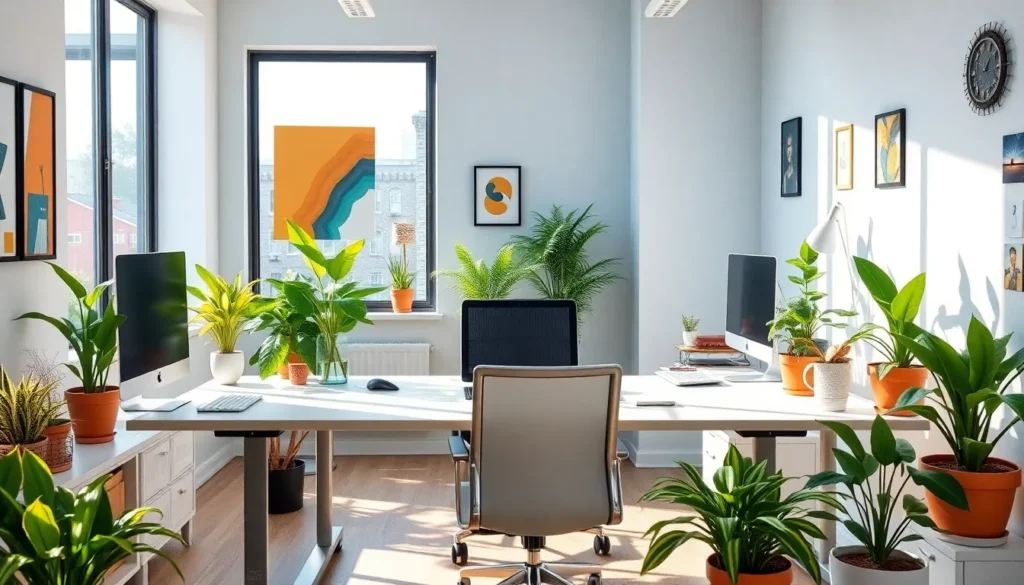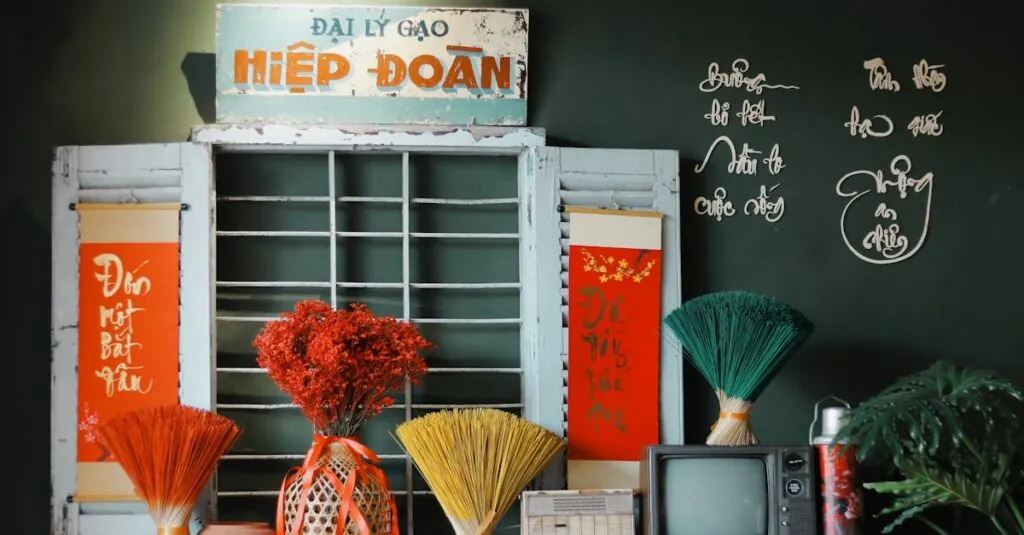Table of Contents
ToggleAsian interior design isn’t just a trend; it’s a lifestyle choice that brings harmony and elegance into any space. Imagine walking into a room filled with soothing colors, natural materials, and a sense of tranquility that instantly makes your stress disappear. It’s like a mini-vacation for your senses without the hassle of packing a suitcase.
From the minimalist charm of Japanese aesthetics to the vibrant colors of Indian decor, Asian design offers a delightful blend of tradition and modernity. Whether you’re looking to create a serene sanctuary or a lively gathering space, incorporating these elements will not only elevate your home but also impress your guests. So, why settle for ordinary when you can transform your living space into a stunning reflection of culture and peace? Let’s dive into the enchanting world of Asian interior design and discover how it can redefine your home.
Overview of Asian Interior Design
Asian interior design embodies a lifestyle that emphasizes balance, tranquility, and beauty. This design style incorporates calming colors and natural materials, which create serene environments that significantly reduce stress levels. Elements such as bamboo, wood, and stone often appear in designs, contributing to a connection with nature.
Japanese design typically embraces minimalism. Clean lines, uncluttered spaces, and a focus on functionality characterize this aesthetic, allowing for a peaceful atmosphere. In contrast, Indian decor frequently showcases bold colors, intricate patterns, and rich textures, reflecting cultural vibrancy and tradition. Both styles demonstrate how diverse Asian design can be, offering discrete experiences while promoting harmony.
In Asian interiors, Feng Shui principles frequently guide layout and decor choices. Proper placement of furniture and decor items fosters positive energy flow in a space. Incorporating water features, plants, or artwork can enhance this effect, promoting feelings of relaxation and well-being.
Asian interior design can also blend traditional and contemporary elements. Mixing rustic furniture with modern fixtures highlights personal expression and cultural appreciation. This versatility allows individuals to create unique spaces that resonate with their preferences while honoring cultural heritage.
As individuals explore Asian interior design, they discover a rich tapestry of influences and styles that cater to a variety of tastes. The tranquil aesthetic and harmonious arrangements help create peaceful havens that enhance overall well-being. Adopting this design philosophy encourages deeper connections with one’s living space, transforming homes into culturally rich sanctuaries.
Key Elements of Asian Interior Design
Asian interior design emphasizes tranquility and balance, incorporating specific elements that create harmonious living spaces. These key components include thoughtful color palettes, unique furniture styles, and diverse textiles.
Color Palettes
Asian interiors often feature calming color palettes, focusing on earthy tones and muted shades. Consider the use of soft greens, browns, and blues that evoke nature’s essence. Japanese design typically emphasizes monochromatic colors, enabling a minimalist approach that maximizes serenity. In contrast, Indian design embraces vibrant hues, including rich reds and yellows, celebrating joyful energy. This combination showcases the spectrum of choices within Asian design, allowing individuals to curate spaces that resonate with personal aesthetics.
Furniture Styles
Furniture in Asian interior design reflects simplicity and functionality. Japanese styles often present low furniture, which encourages relaxation and an unfettered connection to the ground. Natural materials, such as wood and bamboo, dominate these designs, enhancing environmental ties. Meanwhile, Indian furniture frequently features intricate carvings and bold embellishments, showcasing artistry that tells a story. This diversity in styles provides options for creating spaces that balance functionality with visual interest, embodying cultural significance.
Textiles and Patterns
Textiles play a crucial role in Asian interior design, introducing layers of texture and intricate patterns. Natural fibers, such as silk and linen, add warmth while contributing to a luxurious feel. Patterns vary widely; traditional Japanese textiles might present subtle motifs, while Indian fabrics boast elaborate designs and bright colors. These textiles harmoniously complement furniture and wall color, enhancing overall aesthetics. The thoughtful integration of diverse fabrics cultivates depth and character, enriching the ambiance of any room.
Popular Asian Design Styles
Asian interior design encompasses various styles, each reflecting unique cultural elements and philosophies. Among these, Japanese minimalism, Chinese traditional, and Indian eclectic stand out with distinctive characteristics.
Japanese Minimalism
Japanese minimalism emphasizes simplicity and functionality. It prioritizes clean lines and neutral color palettes that evoke a sense of tranquility. Low furniture, such as tatami mats and futons, encourages relaxation and a connection with the ground. Natural materials like wood and stone create harmony between interior and exterior spaces. Decorative elements remain minimal, often featuring a single, carefully chosen object that draws attention. This refined aesthetic fosters balance and peace within living areas.
Chinese Traditional
Chinese traditional design showcases rich symbolism and artisanal craftsmanship. Ornate wooden furniture, often intricately carved, serves as focal points in a room. Color plays a significant role, with reds and golds symbolizing good fortune and happiness. Decorative elements, such as silk screens and calligraphy, enhance cultural richness. Layers of textiles and rich patterns contribute to a warm and inviting atmosphere. Overall, this style creates a sense of history and heritage within contemporary homes.
Indian Eclectic
Indian eclectic design celebrates vibrant colors and intricate patterns. Bright hues harmonize with rich textiles, creating lively and inviting spaces. Handcrafted elements, such as carved wooden furniture and ceramic pottery, add authenticity and character. Textiles like rugs and throws introduce texture and visual interest, varying from bold prints to subtle weaves. Integration of traditional and modern aspects fosters personal expression while maintaining cultural significance. This diverse style effortlessly brightens any space, making it uniquely expressive.
Incorporating Asian Elements into Modern Spaces
Integrating Asian elements into modern spaces creates a seamless blend of tradition and contemporary design. This approach fosters a tranquil atmosphere while enhancing aesthetic appeal.
Balance and Harmony
Balance and harmony serve as foundational principles in Asian interior design. Creating a sense of equilibrium can involve using symmetrical layouts and strategically placing furniture. Focus remains on clear pathways and open spaces for enhanced movement. Selecting decor items that share visual weight also enhances this balance. Incorporating natural elements like plants can further promote harmony by connecting interior spaces with the outdoors. Such choices contribute to an inviting environment where mindfulness thrives.
Nature and Serenity
Nature and serenity play critical roles in defining Asian design aesthetics. Natural materials such as wood, stone, and bamboo evoke a sense of calmness and tranquility. Designers can opt for earthy tones to create soothing palettes that mirror the soothing elements found in nature. Large windows and open spaces flood interiors with natural light, contributing to an airy feel. Artwork featuring landscapes or flora complements this connection, infusing spaces with serenity. By prioritizing these elements, individuals cultivate peaceful retreats that enhance overall well-being and relaxation.
Asian interior design offers a unique approach to creating harmonious living spaces that prioritize tranquility and balance. By blending traditional elements with contemporary aesthetics, individuals can transform their homes into serene retreats. The thoughtful use of natural materials and calming color palettes fosters a connection to nature that enhances overall well-being.
Whether one leans towards the minimalist elegance of Japanese design or the vibrant intricacies of Indian decor, there’s an Asian style that resonates with every personal taste. As people embrace these diverse influences, they not only enrich their environments but also cultivate spaces that reflect their cultural appreciation and individual expression.







